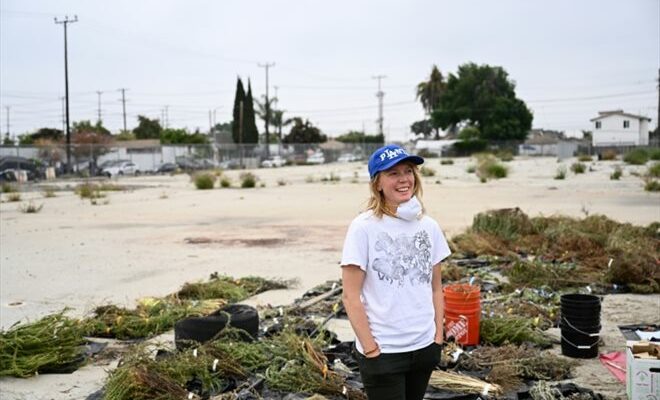Researcher Danielle Stevenson digs up a plant for analysis, on a brownfield site in Los Angeles, May 19, 2023 (AFP/Patrick T. Fallon)
In the middle of an industrial wasteland in the heart of Los Angeles, Kreigh Hampel uproots a California buckwheat with a pitchfork to have it analyzed: since it was planted, the shrub has been absorbing lead polluting the soil of this former automotive website.
The 68-year-old volunteer marvels at the cleaning power of this bush dotted with white and pink flowers.
“It’s the miracle of life,” enthuses the pensioner behind his filter mask. “Plants really know how to do this job, they’ve done it plenty of times over millions of years.”
On this land long covered in concrete, scientists from UC Riverside University have disseminated carefully chosen plants and fungi, with the hope of naturally eliminating the heavy metals and petrochemicals that have contaminated the neighborhood for decades.

Volunteer Kreigh Hampel helps dig up plants for analysis at a brownfield site in Los Angeles on May 19, 2023 (AFP/Patrick T. Fallon)
This technique, known as “bioremediation”, represents a much more economical alternative to the usual processes.
“The conventional method of cleaning up sites consists of digging up all the contaminated soil and dumping it elsewhere,” researcher Danielle Stevenson, who is leading this life-size study, reminds AFP. “Very expensive”, this approach often amounts to “millions” and “only moves the problem elsewhere”.
Conversely, this mycologist’s project, carried out on three different former industrial sites in Los Angeles, costs only “200,000 dollars”. And according to her, the first results are promising.
– “Vacuum cleaners” and “decomposers” –
“In three months, we reduced petrochemicals by 50% and, in six months, we got closer (to this threshold) for certain metals”, she relates.

The roots of a plant capable of absorbing heavy metals are weighed before analysis, on an industrial wasteland in Los Angeles, May 19, 2023 (AFP / Patrick T. Fallon)
The scientist chose her anti-pollution weapons carefully.
On the one hand, white oyster mushrooms have been integrated into the ground because they are “decomposer” mushrooms: their underground part, called “mycelium”, feeds on both dead trees and hydrocarbons such as diesel.
“It’s because it’s essentially the same thing,” says the 30-year-old. “Much of our fossil fuels are just dead materials that have been compressed over long periods of time.”
On the other hand, several local California plants act as “vacuum cleaners” for heavy metals — which can then be reused. To survive in hostile soil, they receive help from mycorrhizal fungi, natural allies of the forest which provide them with water and nutrients in particular.
In this popular neighborhood with a Latin American majority, Ms. Stevenson wants to bring the concentrations of pollutants below the health thresholds set by the American authorities. Because living near former contaminated industrial sites “literally reduces life expectancy”.

Two volunteers work on a brownfield site in Los Angeles on May 19, 2023 (AFP/Patrick T. Fallon)
Historically, the polluters are rarely the payers. After the departure of the companies, cleaning is often the responsibility of the communities, which take years to find the necessary funding.
In the United States, where the Environmental Protection Agency (EPA) identifies nearly 1,900 problematic sites, the depollution projects carried out each year can be counted on the fingers of one hand, according to the scientist.
Proposing a “cheaper” method would allow “more sites to be cleaned up more quickly”, she hopes.
– Anti-fungi prejudices –
Cleaning wastewater, remediation of soil contaminated by toxic ash from forest fires, frequent in California… “Bioremediation” can be applied to many areas, according to her.

A plant capable of absorbing heavy metals is collected before analysis, on an industrial wasteland in Los Angeles, May 19, 2023 (AFP / Patrick T. Fallon)
But then, why is this technique still so underdeveloped?
“Bioremediation is still considered risky,” says Bill Mohn, professor of microbiology at the University of British Columbia, Canada. Unlike soil excavation, “it is difficult to systematically guarantee that we will go below the required levels of pollutants”.
An uncertainty reinforced by the lack of funding for research, in a field that has no concrete product to sell, he adds.

Researcher Danielle Stevenson, among the plants she uses to clean up an industrial wasteland in Los Angeles, May 19, 2023 (AFP / Patrick T. Fallon)
Stigma against unhealthy mushrooms also dies hard, says Stevenson.
“I am always asked if, by introducing a fungus to clean a site, it will not take over, infect the house and spread everywhere”, she says.
Hence the importance of conducting this type of study in real conditions, and not just in the laboratory, in order to test the viability of this natural approach.
“Once we have more tests of these methods in the field, people will feel more confident,” says the researcher.
© 2023 AFP
Did you like this article ? Share it with your friends with the buttons below.




